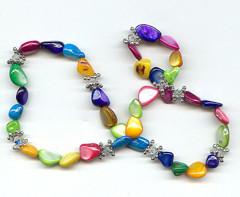Jewelry-Making DIY Basics – What is a Crimp?
By Paul Brandon
Crimps play an important part in jewelry design, but their roles in jewelry design are often ignored for the more visible parts.
What is a jewelry crimp?
A jewelry crimp is a device that can be pinched or pressed together with the purpose of holding findings onto a jewelry piece or fixing beads in place. Jewelry crimps usually take one of four forms: crimp tubes, crimp beads, crimp-on eyes and crimp-on hooks.
Jewelry beads are spheres with the hole cut through. When they are flattened, they usually form an hourglass shape. Crimp tubes have a uniform diameter and flatten into rectangles. Twisted crimp tubes have a spiral pattern cut into the tubes that might add patterns to the crimp, but they still flatten into rectangles.
[Hidepost=1]
How are jewelry crimps used?
Bead Wire Projects
A first use of crimp tubes and crimp beads is to fasten findings such as toggles or lobster claw clasps and jump rings onto stranded beading wire. Starting with 2 to 3 inches of bead wire, slide on a crimp tube or crimp bead. Slide the finding (ring of toggle loop, ring of toggle stick, jump ring or lobster claw clasp) onto the bead wire approximately half way — 1 to 1-1/2 inches, folding the bead wire around the finding without creasing the wire. Thread the free end of the wire back through the crimp bead. Pull the crimp close enough to the finding to minimize the free bead wire but far enough from the finding that it will move freely. If the connection is “rigid”, with the bead wire against the finding, the wire will show wear sooner than necessary. Use chain nose pliers with smooth jaws to flatten the crimp. Grab the crimp between the jaws and squeeze firmly then release. The second side of the jewelry piece should have a bit more bead wire so the free “tail” of the bead wire can be pulled to take the slack from between the beads and the crimp.
Some use two alternate tools for crimping: two stage crimping pliers and magic crimping pliers. Two stage crimping pliers put an initial “v” shape into the crimp; the second stage wraps the crimp tight around the wires. Two issues with this two stage crimping pliers are:
* The “v” weakens the crimp by bending it past 180 degrees.
* This crimping method seems to damage the underlying bead wire. (This is important if the bead wire piece has to be reworked for size or design.)
The magic crimping pliers “round” the crimp into a bead/crimp hybrid. Two problems with magic crimping pliers are:
* Getting the right grip on the crimp tubes is not easy.
* Flattening the crimp and covering it with a crimp cover is much easier for almost the same look.
Floating Bead Projects
Jewelry crimps are also used with bead wire or beading chain to “float” beads in a style like the “tin cup” necklace popularized by Rene Russo in the 1996 movie of the same name. In this case, the crimps should fit snugly around the beading chain or beading wire. For instance, 1.5mm diameter or 1.1mm diameter (outside diameter) crimps will fit a 0.6mm beading chain or beading wires in .018″, .015″ or .012″ diameters.
Crimp-on Eyes and Hooks
Crimp-on eyes and crimp-on hooks are ideal for some jewelry pieces, such as those using the 0.6mm beading chain or some cords such as leather. Place a single end of cord or chain into the tube. Press the crimp tube onto the cord or chain with chain nose pliers. Gently tug on the crimp to see that it holds.
Foldover findings are sometimes used on the ends of cords. However, the author feels that they should be ranked behind many other methods of crimping for ease of use and appearance.
Sizing Crimps
Crimps are available in a variety of sizes. Two strands of bead wire between .012″ and .019″ should be able to fit into a 2mm diameter crimp tube; larger crimp tubes may not hold the wires securely and smaller crimp tubes will not fit the wires through the tube very well. Crimp tubes of 1.5mm diameter may be more suitable for .010″ or .012″ diameter wires. Fabric cords should be tested with crimps to verify holding power.
Crimp Materials
Crimps tubes are available in many metals to match the primary metal of the jewelry piece: gold-filled, sterling, and plate over brass. Crimp beads are more often available only in the base metals. Crimp-on eyes and hooks are often available in gold-filled, vermeil (gold over sterling), sterling and some plated metals. Silver-plated crimp beads have a reputation for cracking that the copper-plated and gunmetal-plated brass crimp tubes do not show.
Jewelry crimps form the foundation for the longevity of jewelry pieces. Jewelry designers need to determine the highest quality crimp materials and methods to keep their jewelry pieces from falling apart. Quality of the finished piece many times depends on the quality of the crimping.
Paul Brandon knows crimps and sells jewelry chain and other components at http://www.OhioBeads.com
Article Source: here
[/Hidepost]
+



 Click
Click